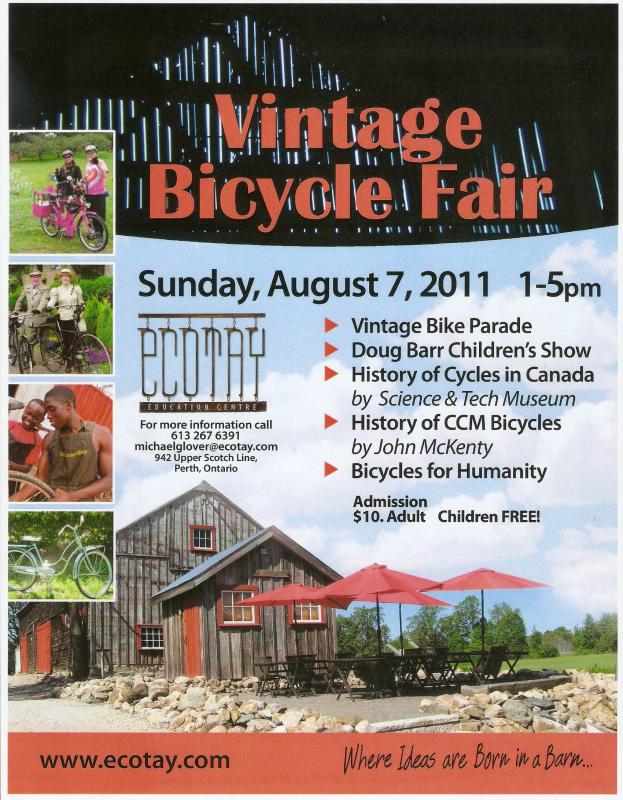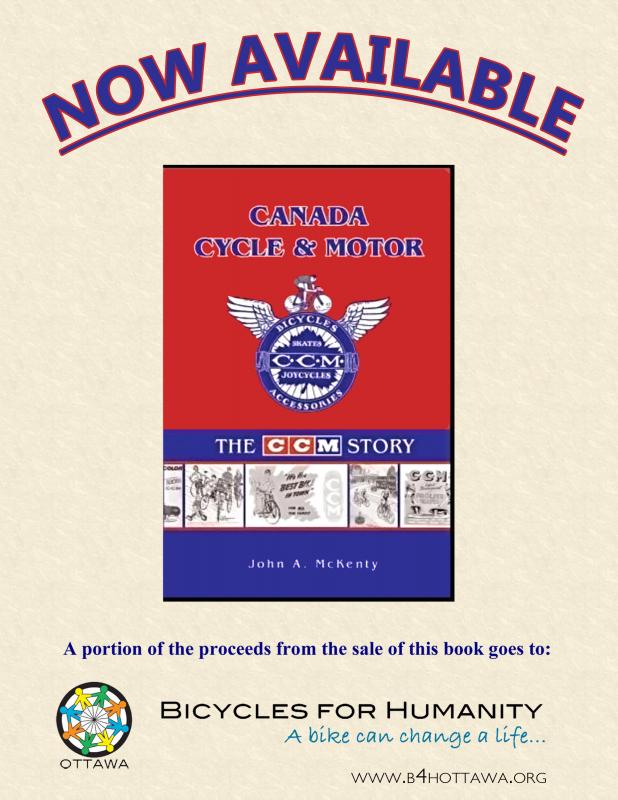Archives

Presents
A Book Signing with John McKenty
Author of Canada Cycle & Motor: The CCM Story

Saturday, November 19
10:00 a.m. - 2:00 p.m.
156 Princess St.
Kingston ON


Above: Bob Nevin, outfitted in his CCM finest, as a member of the 1962 Stanley Cup champion Toronto Maple Leafs. Below: Bob helping to celebrate the 50th anniversary of Peter's Barber Shop in downtown Weston this past Saturday along with the Stanley Cup and some fellow who wrote a book about CCM.


The Etobicoke Historical Society presents:
Canada Cycle & Motor: The CCM Story
Presentation & Book Signing
Thursday, October 27
7:30 p.m.
Community Room, Montgomery's Inn
4709 Dundas St. W.


Terry Sawchuck 1929 - 1970

The most dominant bicycle racer in the world at the dawn of the 20th century was the incomparable Marshall Walter Taylor. Born to a black couple in rural Indiana, Taylor was raised and educated in the home of a wealthy white Indianapolis family who employed his father as a coachman and gave the youngster his first bicycle. He became so good on it that by the age of fourteen he was hired to perform cycling stunts outside an Indianapolis bicycle shop. Dressed as he was in a soldier's uniform Taylor earned the nickname Major.
By the time he was eighteen Major Taylor had broken two world records, but his feats offended white sensibilities with the result that he was often banned from racing at many events. Despite this and the illegal tactics employed against him by many of his competitors by 1898 Taylor held claim to seven world records.
On August 10, 1899, Taylor used his Massey-Harris Silver Ribbon to capture the world 1-mile championship in Montreal to become only the second black athlete to hold a world title.
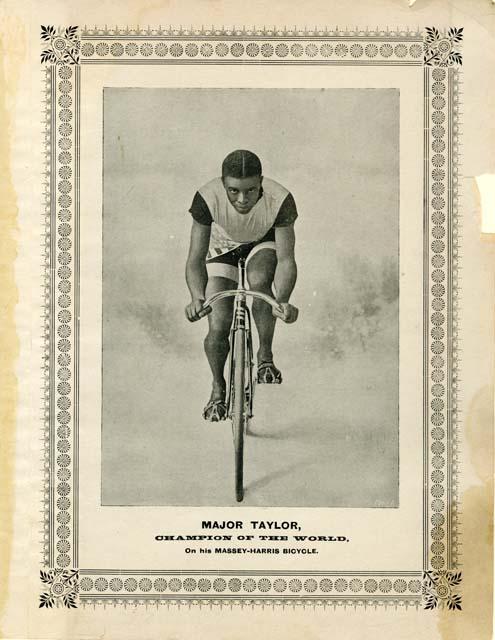
When Taylor toured Australia in 1903 he won over the crowds and the Australian cyclists with his geniality and generosity. "What particularly surprised the local riders was the Major's willingness to train with them, side by side. They had expected him to do much of his work in secret. Contrary to all expectations he unhesitatingly displayed his Massey-Harris bicycle and allowed them to size it up for themselves, the gearing, the cranks, the frame, and the pedal reach. These were commonly considered secrets in the trade. Of considerable interest were his adjustable handlebars. They were new to the country; and for decades afterward Australian cyclists commonly referred to adjustable ones as 'Major Taylors'" (James Fitzpatrick - Major Taylor in Australia)
Despite the shadow of racism that dogged his career, Major Taylor went on to beat the best that Europe, Australia, New Zealand and the States had to offer. Taylor retired from competitive racing in 1910, but after two decades of illness and unsuccessfull business ventures died in the Charity Ward of the Cook County Hospital in Chicago in 1932 and was buried in an unmarked grave. In 1948 a group of former pro bicycle racers had Taylor's remains exhumed and reburied in a more prominent part of Mount Glenwood Cemetery in Illinois.
"Dedicated to the memory of Marshall W. 'Major' Taylor, 1878-1932. World's champion bicycle racer who came up the hard way without hatred in his heart, an honest, courageous and god-fearing, clean-living, gentlemanly athlete. A credit to the race who always gave out his best. Gone but not forgotten."
Inscription on the gravestone of Major Taylor

Photo courtesy of Larry Healey


UPCOMING SHOWS
CHRISTIE ANTIQUE SHOW
1000 Highway 5 West
Dundas, ON
Saturday, September 10
A buddy of mine will have copies of Canada Cycle & Motor: The CCM Story available at the Christie Antique Show. Look for the Otter Creek Antiques booth.
WOODSTOCK NOSTALGIA SHOW
Woodstock Fairgrounds
875 Nellis Street
Woodstock, ON
Sunday, September 11
I will have a table with some copies of the book as well as a few old bicycle catalogs for sale in Woodstock. If you're in the neighbourhood, drop by and say hello.
When CCM was formed in 1899, one of the companies involved in the original merger was the Canadian division of the H.A Lozier Co., based in Cleveland, Ohio and makers of the well-known Cleveland bicycle.
From the beginning the CCM directors had decided that production of the three Toronto companies involved in the merger (Gendron + Massey-Harris + Lozier) would be concentrated in one plant and that plant would be the Lozier plant on Weston Road in what was then known as West Toronto Junction.
Below are two illustrations of that particular plant sent along by Larry Healey of Campbellford. The top one is a sketch from a 1910 company catalogue and the one below is a photograph used courtesy of Jack Gordon, Newcastle, ON.
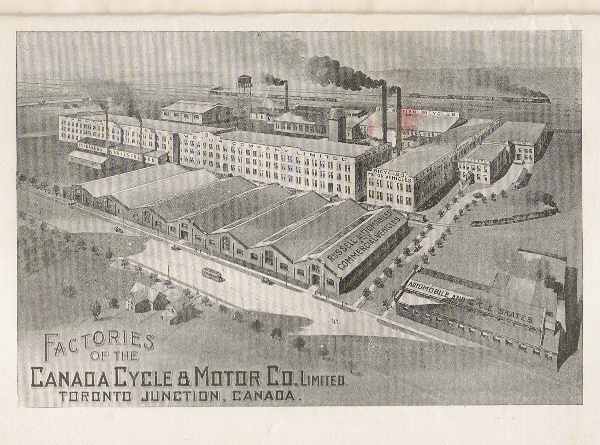

Very few visuals of this particular plant still exist. Thanks to Larry for sharing these ones.
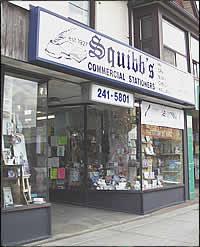
For those in the Toronto area who don't trust the mail or would like to have a book in hand before laying down their hard-earned cash, you can pick up your copy of Canada Cycle & Motor: The CCM Story at Squibb's Stationers, 1974 Weston Road, right across from where the old CCM plant once stood. Drop in and see Suri and she'll make sure you have a book before you leave.
In last Sunday's Toronto Sun noted Toronto historian Mike Filey declared Canada Cycle & Motor: The CCM Story to be "a must read for Canadian history buffs."
Well known Canadian antiques dealer and longtime collector of CCM memorabilia Larry Foster wrote: "Great book John and a tribute to a Canadian company that flourished despite all the challenges. Your research is astounding."





